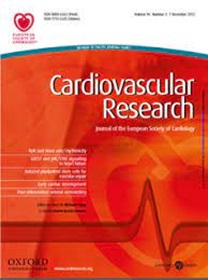microRNA-26b的缺失通过调控细胞特异性靶基因促进主动脉钙化
IF 13.3
1区 医学
Q1 CARDIAC & CARDIOVASCULAR SYSTEMS
引用次数: 0
摘要
目的血管钙化是指血管内磷酸钙的异常沉积。这种情况与心血管疾病的发展显著相关,但其潜在机制在很大程度上仍不清楚。MicroRNAs (miRNAs)可能通过调节特定细胞靶点网络在启动血管钙化中起着至关重要的作用。在这项研究中,我们首次探索了microRNA-26b (miR-26b)在血管钙化中的潜在作用。方法和结果采用微正电子发射断层扫描和微pet /CT(微pet /CT)成像,用18f -氟化钠检测miR-26b敲除小鼠(miR-26bKO)的主动脉钙化情况。我们进行了大量RNA测序(RNA-seq)、单细胞RNA测序和网络分析,以确定细胞特异性靶点和导致所观察到的表型的细胞复杂性。此外,我们检查了主动脉瘤或瓣膜相关主动脉病变患者的主动脉组织,以确定miR-26b及其靶点的表达水平如何与钙化相关。我们的研究结果显示,miR-26b在主动脉钙化患者的主动脉组织中下调,而miR-26b的表达与钙化水平呈负相关。同样,miR-26bKO小鼠出现自发的与年龄相关的主动脉微钙化。结合单细胞转录组学和网络分析,我们确定并绘制了miR-26b的细胞类型特异性靶点和调控途径。此外,我们验证了Smad1在平滑肌细胞(SMCs)中的细胞特异性表达,并表征了主动脉细胞之间的细胞间交流,揭示了骨形态发生蛋白(BMP)途径。微钙化的发展归因于成纤维细胞(FBLs)释放的Bmp4,导致miR-26bKO小鼠SMCs中Smad1磷酸化和钙积累。我们发现主动脉微钙化可以通过破坏细胞通讯在药理学上逆转。最后,我们证明了钙化主动脉组织中miR-26b和SMAD1水平之间的负相关。结论miR-26b缺乏对主动脉钙化的启动和促进至关重要,为主动脉疾病的治疗提供了新的靶点。本文章由计算机程序翻译,如有差异,请以英文原文为准。
The loss of microRNA-26b promotes aortic calcification through the regulation of cell-specific target genes
Aims Vascular calcification is the abnormal deposition of calcium phosphates within blood vessels. This condition is significantly associated with the development of cardiovascular disease, yet the underlying mechanisms remain largely unknown. MicroRNAs (miRNAs) may be crucial in initiating vascular calcification by regulating a network of specific cellular targets. In this study, we explored for the first time the potential role of microRNA-26b (miR-26b) in vascular calcification. Methods and results Using micro-positron emission tomography and computed tomography (micro-PET/CT) imaging with 18F–sodium fluoride, we measured aortic calcification in miR-26b knockout mice (miR-26bKO). We conducted bulk RNA sequencing (RNA-seq), single-cell RNA sequencing, and network analysis to identify cell-specific targets and the cellular complexity contributing to the observed phenotype. Additionally, we examined aortic tissues from patients with aortic aneurysm or valvular-related aortopathy to determine how the expression levels of miR-26b and its targets correlate with calcification. Our findings revealed that miR-26b is downregulated in the aortic tissues of patients with aortic calcification, whereas miR-26b expression negatively correlates with calcification levels. Similarly, miR-26bKO mice developed spontaneous age-related aortic microcalcifications. Combining single-cell transcriptomics with network analyses, we identified and mapped cell-type specific targets of miR-26b and regulatory pathways. Furthermore, we validated the cell-specific expression of Smad1 in smooth muscle cells (SMCs) and characterized the cell–cell communication between aortic cells, exposing the bone morphogenetic protein (BMP) pathway. The development of microcalcification was attributed to Bmp4 released from fibroblasts (FBLs), leading to Smad1 phosphorylation and calcium accumulation in SMCs of miR-26bKO mice. We found that aortic microcalcification could be pharmacologically reversed by disrupting cellular communication. Lastly, we demonstrated an inverse correlation between miR-26b and SMAD1 levels in calcified aortic tissues. Conclusion The deficiency of miR-26b is crucial for initiating and promoting aortic calcification, revealing new therapeutic targets for aortic disease.
求助全文
通过发布文献求助,成功后即可免费获取论文全文。
去求助
来源期刊

Cardiovascular Research
医学-心血管系统
CiteScore
21.50
自引率
3.70%
发文量
547
审稿时长
1 months
期刊介绍:
Cardiovascular Research
Journal Overview:
International journal of the European Society of Cardiology
Focuses on basic and translational research in cardiology and cardiovascular biology
Aims to enhance insight into cardiovascular disease mechanisms and innovation prospects
Submission Criteria:
Welcomes papers covering molecular, sub-cellular, cellular, organ, and organism levels
Accepts clinical proof-of-concept and translational studies
Manuscripts expected to provide significant contribution to cardiovascular biology and diseases
 求助内容:
求助内容: 应助结果提醒方式:
应助结果提醒方式:


